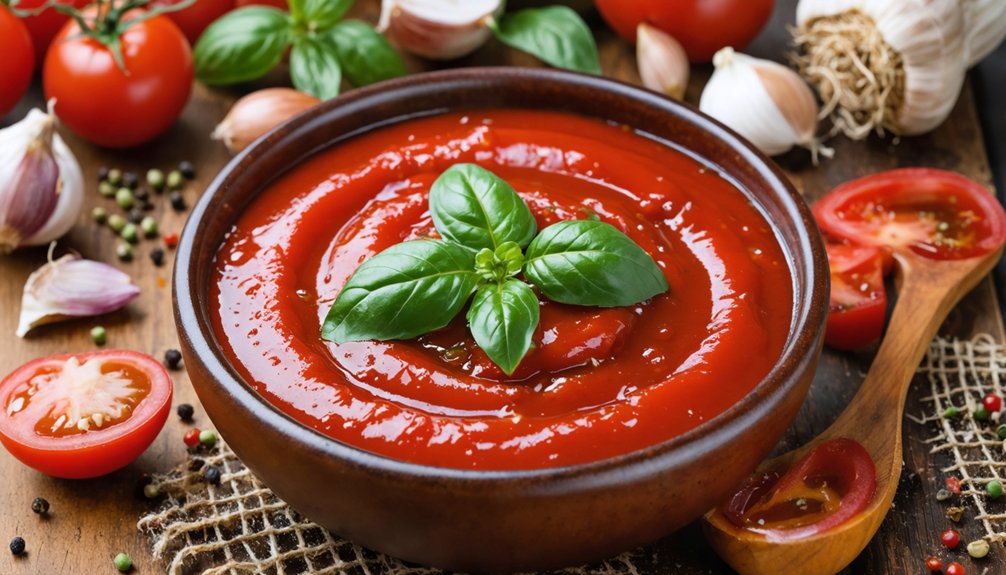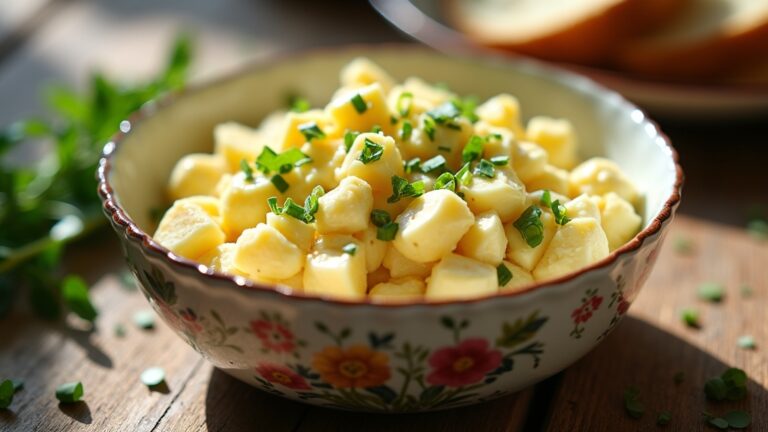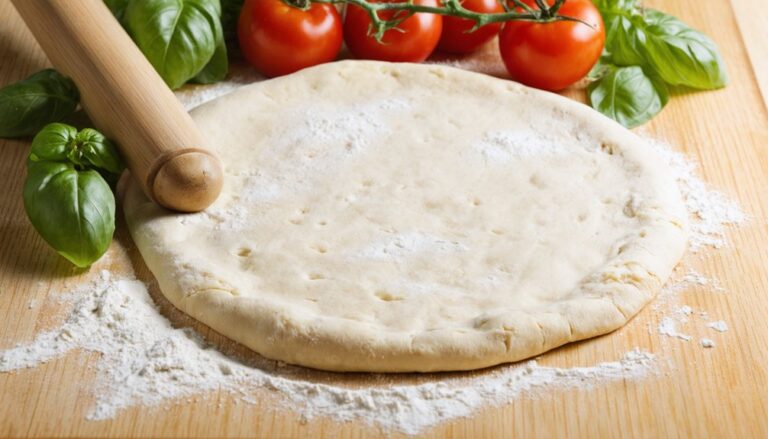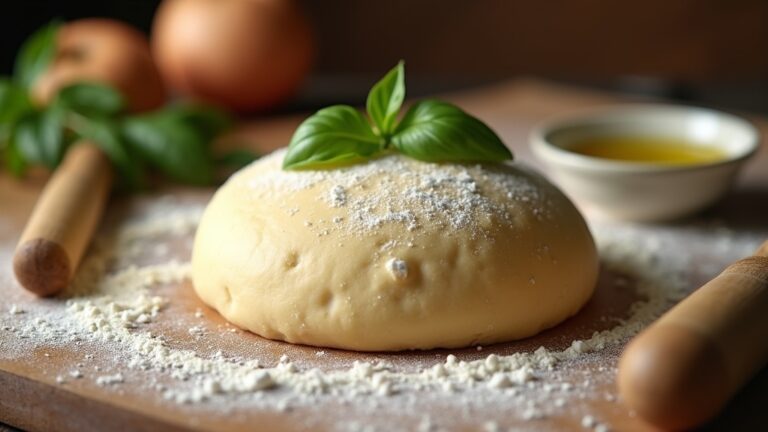Pizza Sauce Recipe
To make a delicious homemade pizza sauce, blend ripe tomatoes with garlic, herbs, and olive oil. Simmer the mixture to enhance the flavors, adding salt and a touch of sugar to balance acidity. This sauce not only elevates your pizza but also gives you control over the ingredients for a healthier option. Customize it with your favorite spices and herbs for a unique twist. There’s so much more you can explore about this culinary delight!
Contents
History
When you think about pizza sauce, it’s easy to overlook its rich history, but this essential ingredient has roots that stretch back centuries. Its ancient origins can be traced to the Mediterranean, where tomatoes blended with garlic, herbs, and olive oil created a vibrant flavor profile. As tomatoes traveled from the New World to Italy in the 16th century, they became a staple, revolutionizing Italian cuisine. The Italian influence on pizza sauce is undeniable; it embodies the spirit of simple, fresh ingredients. Each dollop of sauce tells a story, reflecting the passion and creativity of countless generations. So, the next time you savor that tangy, aromatic sauce, remember the journey it took to grace your slice, celebrating its rich heritage.
Recipe
Making your own pizza sauce from scratch can elevate your homemade pizza experience, providing a fresh and flavorful base that store-bought sauces often lack. This simple recipe uses a blend of ripe tomatoes, aromatic herbs, and spices to create a rich and tangy sauce that pairs perfectly with your favorite pizza toppings. Not only is it easy to prepare, but it also allows you to control the ingredients, guaranteeing a healthier option for you and your family.
To get started, you’ll want to gather all the necessary ingredients to guarantee a smooth cooking process. The key to a great pizza sauce is quality tomatoes, which provide the foundation for the flavor. Fresh herbs like basil and oregano add a fragrant touch, while garlic and onion enhance the overall depth of the sauce. With just a few simple steps, you’ll have a delicious pizza sauce ready to spread on your dough.
Ingredients:
- 2 cups canned whole tomatoes (or fresh tomatoes, peeled and chopped)
- 2 tablespoons olive oil
- 1 small onion, finely chopped
- 2 cloves garlic, minced
- 1 teaspoon dried oregano
- 1 teaspoon dried basil
- 1/2 teaspoon sugar
- Salt and pepper to taste
In a medium saucepan over medium heat, warm the olive oil and sauté the chopped onion until translucent, about 5 minutes. Add the minced garlic and cook for an additional minute, being careful not to let it burn. If using canned tomatoes, crush them in your hands as you add them to the pan, or use a fork to break them up. Stir in the oregano, basil, sugar, salt, and pepper, then bring the mixture to a simmer. Reduce the heat to low and let the sauce cook for about 20-30 minutes, stirring occasionally, until it thickens to your desired consistency.
For the best flavor, allow the sauce to cool and refrigerate for at least an hour before using it on your pizza. This resting time helps the flavors meld together beautifully. Additionally, feel free to customize the sauce by adding red pepper flakes for a spicy kick or experimenting with other herbs like thyme or parsley. This sauce can also be made in larger batches and frozen in portions for a quick pizza night in the future!
Cooking Steps
Now that you have your ingredients ready, it’s time to bring your pizza sauce to life. Start by gathering fresh tomatoes and blending them with your favorite herbs for that perfect base. Once you’ve got your mixture, simmer the sauce to enhance the flavors, and don’t forget to taste and adjust the seasoning for a truly delicious finish.
Step 1. Gather Fresh Tomatoes
Gathering fresh tomatoes is an essential step in crafting a delicious pizza sauce that bursts with flavor. To achieve this, seek out local sourcing options—farmers’ markets or community gardens are perfect for discovering ripe, juicy tomatoes. Consider exploring various tomato varieties; heirloom, San Marzano, or Roma tomatoes each bring their unique taste and texture to your sauce. When picking, choose tomatoes that are vibrant in color and feel slightly firm to the touch. The fresher the tomatoes, the more robust the flavor you’ll capture in your sauce. Don’t shy away from asking local farmers for their recommendations; they often have insights on the best tomatoes in season. With these tips, you’re well on your way to pizza sauce perfection!
Step 2. Blend Tomatoes and Herbs
Transform your fresh tomatoes into a vibrant sauce by blending them with aromatic herbs. Start by choosing your favorite tomato varieties—Roma, San Marzano, or heirloom all offer unique flavors. Chop them into quarters, then toss them into your blender. Next, add your preferred herb combinations; basil, oregano, and thyme bring a delightful freshness. For a hint of sweetness, consider a pinch of sugar or a splash of balsamic vinegar. Blend everything until smooth, adjusting the consistency to your liking. You can leave it chunky for a rustic feel or puree it for a silky texture. This mixture will be the heart of your pizza sauce, bursting with the essence of summer and ready to elevate your homemade pizza!
Step 3. Simmer Sauce for Flavor
Once you’ve blended your tomatoes and herbs, it’s time to let the magic happen by simmering the sauce. This step is vital for flavor enhancement, allowing all those vibrant ingredients to meld beautifully. Use simmer techniques like adjusting the heat to maintain a gentle bubble, which prevents burning while intensifying the taste. Stir occasionally to guarantee nothing sticks to the bottom, inviting a rich aroma throughout your kitchen. Aim for a simmering time of 20 to 30 minutes; this patience pays off with a deeper, fuller flavor. You’ll notice the sauce thickening as it cooks, transforming into a luscious base for your pizza. Embrace the freedom to adjust spices and sweetness as it simmers, creating a sauce that’s uniquely yours!
Step 4. Add Olive Oil and Salt
Drizzle a generous amount of olive oil into your simmering sauce to elevate its richness and depth. This golden elixir not only enhances flavor but also brings a wealth of olive oil benefits, including heart-healthy fats and antioxidants. As the oil swirls into your sauce, you’re creating a velvety texture that coats every bite of your pizza.
Next, it’s time to add salt, but don’t just reach for any old variety. Experiment with different salt varieties, like sea salt or Himalayan pink salt, to find the perfect balance of flavor. Each type brings its unique mineral notes, transforming your sauce into a mouthwatering masterpiece that’ll make your homemade pizza irresistible. Enjoy the freedom of flavor!
Step 5. Taste and Adjust Seasoning
After adding olive oil and salt, your sauce will be rich and flavorful, but it’s important to guarantee it’s just right for your taste. Start with some taste testing; grab a spoon and savor a small sample. Is it too tangy, or perhaps lacking depth? This is the moment for flavor balancing! You can add a pinch of sugar to cut acidity or a dash of garlic powder for an extra kick. If it feels flat, a splash of vinegar can brighten it up. Don’t hesitate to experiment—seasoning is all about personal preference. Keep adjusting until you find that perfect harmony that makes your taste buds dance. Remember, this sauce is your canvas; make it uniquely yours!
Nutritional Guide
Understanding the nutritional profile of your pizza sauce can enhance your culinary experience and health. By knowing the caloric content and ingredient benefits, you can make informed decisions that align with your lifestyle.
Here’s a quick glance at the nutritional aspects of common pizza sauce ingredients:
| Ingredient | Calories per 100g | Nutritional Benefits |
|---|---|---|
| Tomatoes | 18 | Rich in vitamins C and A |
| Olive Oil | 884 | Healthy fats, heart-healthy |
| Garlic | 149 | Boosts immunity, anti-inflammatory |
| Herbs (Basil) | 23 | Antioxidants, aids digestion |
This table helps you see how each component contributes to your sauce, allowing you to savor both flavor and nourishment. Enjoy crafting your delicious, health-conscious pizza sauce!
Final Thoughts
Crafting your own pizza sauce not only elevates your culinary skills but also allows you to control the nutritional quality of your meal. Imagine the satisfaction of blending your favorite ingredients to create a sauce that’s uniquely yours. You can experiment with sauce variations, adding fresh herbs or spices to suit your taste. Plus, once you’ve perfected your recipe, proper sauce storage is key. Store your sauce in airtight containers in the fridge for up to a week, or freeze it for longer enjoyment. This way, you’ll always have your homemade delight ready to elevate any pizza night. So, embrace the freedom of customization and let your creativity shine in every jar of sauce you create!
Frequently Asked Questions
Can I Use Store-Bought Sauce Instead of Homemade?
Absolutely, you can use store-bought options! When you make sauce comparisons, you’ll find that some brands offer great flavor and convenience. Just choose a quality one that fits your taste, and enjoy the freedom!
How Long Can I Store Pizza Sauce?
Like a secret treasure, you can store homemade pizza sauce in the fridge for about a week, or up to three months in the freezer. Embrace its longevity, and savor each flavorful moment!
Can I Freeze Leftover Pizza Sauce?
You can definitely freeze leftover sauce! Just pour it into airtight containers, leaving some space for expansion. Label them with dates, and enjoy the freedom of having homemade sauce ready whenever you crave it!
What Are Alternative Herbs for Pizza Sauce?
When you’re crafting flavors, think of your herb garden as a vibrant palette. For oregano substitutes, try marjoram or thyme; for basil alternatives, consider parsley or dill. Each adds a unique touch to your culinary canvas.
Is Pizza Sauce Gluten-Free?
Yes, pizza sauce can be gluten-free! When you choose gluten-free ingredients and focus on sauce thickening techniques, you create a delicious base that allows you to enjoy your pizza without compromising on taste or dietary needs.
Conclusion
As you savor the rich, tangy essence of your homemade pizza sauce, imagine the bubbling cheese and golden crust that await. Each spoonful carries the warmth of Italy, inviting friends and family to gather around the table. You’ve crafted not just a sauce, but a moment of joy and togetherness. So, roll out that dough and let the aroma fill your kitchen, transforming an ordinary meal into a delightful experience that lingers long after the last slice is gone.







